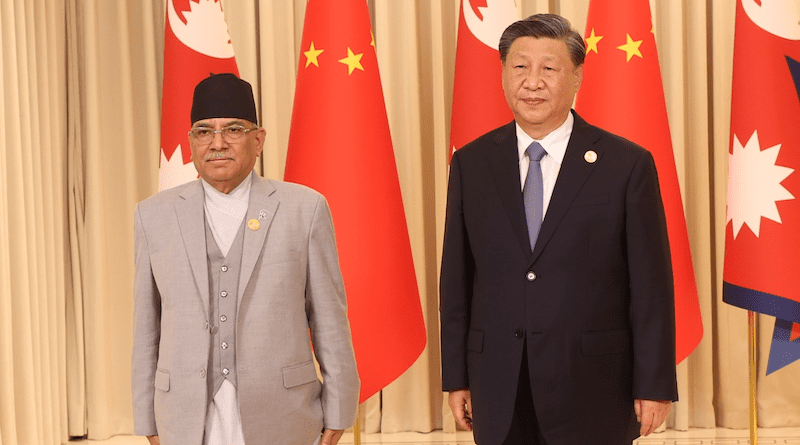Nepal-China Connectivity Endeavours – Analysis
By Institute of South Asian Studies
By Puspa Sharma
Nepal’s Deputy Prime Minister and Foreign Minister Narayan Kaji Shrestha was in China from 24 March to 1 April 2024 on an official trip upon the invitation of his Chinese counterpart, Wang Yi. Since becoming foreign minister after the change in coalition and formation of a new government in Nepal less than a month ago, this was Shrestha’s first foreign trip. A number of issues were discussed during the visit, most of them related to connectivity.
Nepal requested China to re-open the 14 traditional border points between the two countries that China had closed since the COVID-19 pandemic. The closure of these border points has been especially difficult for people living along the Nepal-China border. Only last year, China re-opened four border points, which are crucial for land-based trade between Nepal and China.
Nepal also requested China’s reciprocity on the visa waiver facility. Since 2016, Nepal has waived visa fees for Chinese travellers, and Nepal has, therefore, also requested China to waive the visa fees for Nepali nationals visiting China.
However, a more significant discussion was on the development of an economic and connectivity corridor between the two countries through China’s three provinces – Chongqing, Tibet and Sichuan. The Nepali minister not only visited Beijing but also these three provinces. In recent years, Nepal’s political leaders have been visiting these provinces while visiting Beijing, and there have been high-level visits from these provinces to Nepal, perhaps as part of China’s ‘periphery diplomacy’.
The idea of economic and connectivity corridor development is related to China’s introduction of the Trans Himalayan Multi-Dimensional Connectivity Network under its Belt and Road Initiative (BRI). Nepal signed a memorandum of understanding (MoU) with China in 2017 to participate in the BRI. Thereafter, Nepal identified and proposed 35 projects for implementation under the BRI. However, upon China’s suggestion, the list was shortened to include only nine projects. Of these, one project is on the establishment of a technical institution, three are related to energy and five are focused on transport connectivity, the most prominent of which is the cross-border railway between Nepal and China.
The cross-border railway across the Himalayas will be a difficult and costly endeavour. The pre-feasibility study has highlighted the technical and financial challenges of undertaking this project. A detailed feasibility study is in the process, which will provide further details. However, the project is not considered viable for Nepal.
Usually, China provides loans at commercial interest rates to implement the BRI projects. Therefore, projects that are unable to provide good financial returns struggle to pay back the high-interest-bearing loans. In recent years, several projects in other countries have suffered this fate. Hence, Nepal has been requesting China for grants to implement the BRI projects. This could be a reason that the BRI implementation plan has not been finalised yet.
China had first proposed the draft of the BRI implementation plan in 2019. Since then, Nepal and China have exchanged several communications to revisit the content of the plan. During the recent visit of Nepal’s foreign minister to China, the two countries agreed to finalise this plan soon. According to Nepal’s foreign minister, once the implementation plan is finalised and signed, Nepal will prioritise projects that will be beneficial for his country. The funding modality of the projects (whether grants or loans) will also be discussed later.
There is no doubt that Nepal needs to develop the connectivity and economic corridor with China for it to benefit from China’s economic rise. A well-developed connectivity with China is also necessary to implement the transit transport agreement that Nepal signed with China in 2016, and the protocol to the agreement in 2019. However, while prioritising connectivity projects, those that are technically complex and extremely costly, such as the cross-border railway across the Himalayas, should not be a priority for Nepal since such projects will not provide adequate returns.
Even projects that were expected to provide returns, such as the Pokhara regional airport built with Chinese commercial loans, have failed to provide the expected returns to Nepal. Therefore, other connectivity infrastructures, particularly the construction and upgradation of quality roads that connect Nepal with China, should be Nepal’s priority. Debt overhangs that several countries have been facing in recent years due to unviable projects under the BRI should be considered by Kathmandu in making the project choices.
While the development of an economic and connectivity corridor as well as the other proposed projects under the BRI are important for Nepal, it needs to tread carefully when moving ahead with these plans. Importantly, it will need to finalise the funding modality of these projects for this will have an impact on Kathmandu’s ability to reap the benefits of these projects and make the necessary repayments to China.
- About the author: Dr Puspa Sharma is a Visiting Senior Research Fellow at the Institute of South Asian Studies (ISAS), an autonomous research institute in the National University of Singapore (NUS). He can be contacted at [email protected]. The author bears full responsibility for the facts cited and opinions expressed in this paper.
- Source: This article was published by Institute of South Asian Studies (ISAS)

